- Joined
- Jan 9, 2020
- Messages
- 10,548
- Points
- 938

Thank you very much Vic!By the way, your command of the English language is superb.
 |
As a way to introduce our brass coins to the community, we will raffle off a free coin during the month of August. Follow link ABOVE for instructions for entering. |
 |
 |
The beloved Ships in Scale Magazine is back and charting a new course for 2026! Discover new skills, new techniques, and new inspirations in every issue. NOTE THAT OUR FIRST ISSUE WILL BE JAN/FEB 2026 |
 |

Thank you very much Vic!By the way, your command of the English language is superb.

Just my observation is that the capstan at the entrance to the canopy circled in red and at the front of the canopy there looks very little room for anything else with the mast and bowsprit.Jack I love your comment - thank you! I am very blessed with the wonderful participation I get from all my friends on this log. In many ways I see this as a think tank and a group build. The amazing thing is that every opinion is valuable and counts towards adding information to the total research data of the ship - such is the caliber of the comments.
We do know that for certain parts of the journey, the larger boat was towed (Ab reckons it was towed all the time), but there is also a strong argument to bed made that it was stored on-deck when the crew started encountering the pack ice.
View attachment 303710
The boats being towed. The rounded stern would indicate that these were the "boats" (the larger ones).
View attachment 303711
But here ... when they encountered icy seas with the discovery of Bear Island, the towed boats are missing.
View attachment 303712
Lying at anchor, we see both the sloops and boats out on the water - in fact this painting accounts for the full complement of lifeboats of the two ships.
But ... I know if I look long enough, a solution will become prevalent!
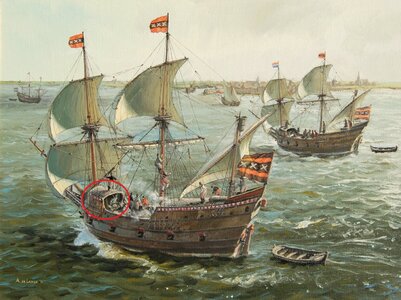

Where is the DOUBLE-LOVE button???Just my observation is that the capstan at the entrance to the canopy circled in red and at the front of the canopy there looks very little room for anything else with the mast and bowsprit.
The small boat only on the deck might be a good compromise and make the larger boat and display the whole thing with a rope attached towing it behind.
View attachment 304064
 I have looked at that picture so many times without spotting what I was so desperately looking for. And in one swell post - you have cleared up all my doubts. At first I preferred Ab Hoving's, and subsequently, Kolderstok's placement of the windlass behind the foremast to Gerald de Weerdt's placement of the windlass behind the front canopy on the Willem Barentsz replica ship. The more I battled with the placement of the windlass in front of the canopy, the more I was having to face reality - it could never have worked in real-life. It just made no sense. And now this picture proves it! Thank you so much - you have just proven ... again ... how valuable our members' contributions are!
I have looked at that picture so many times without spotting what I was so desperately looking for. And in one swell post - you have cleared up all my doubts. At first I preferred Ab Hoving's, and subsequently, Kolderstok's placement of the windlass behind the foremast to Gerald de Weerdt's placement of the windlass behind the front canopy on the Willem Barentsz replica ship. The more I battled with the placement of the windlass in front of the canopy, the more I was having to face reality - it could never have worked in real-life. It just made no sense. And now this picture proves it! Thank you so much - you have just proven ... again ... how valuable our members' contributions are! 
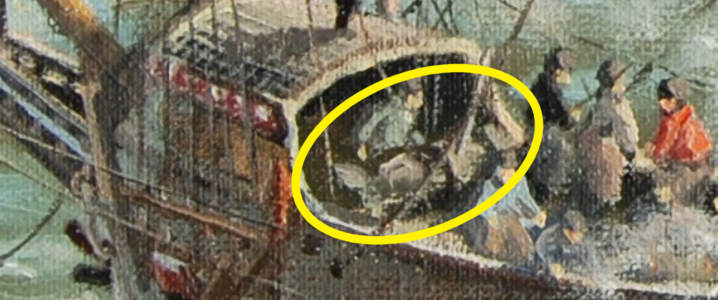
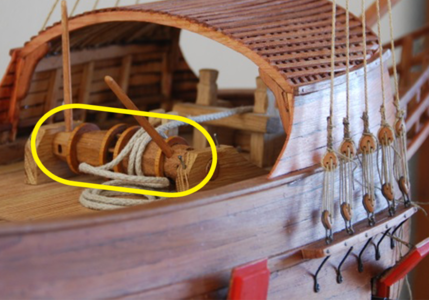
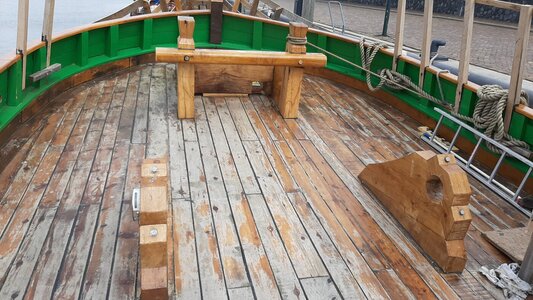

Nope no genius here Heinrich but happy I was able to help you provide some clarity.Where is the DOUBLE-LOVE button???
Richie - my friend - you are an absolute genius.I have looked at that picture so many times without spotting what I was so desperately looking for. And in one swell post - you have cleared up all my doubts. At first I preferred Ab Hoving's, and subsequently, Kolderstok's placement of the windlass behind the foremast to Gerald de Weerdt's placement of the windlass behind the front canopy on the Willem Barentsz replica ship. The more I battled with the placement of the windlass in front of the canopy, the more I was having to face reality - it could never have worked in real-life. It just made no sense. And now this picture proves it! Thank you so much - you have just proven ... again ... how valuable our members' contributions are!
View attachment 304065
The painting, suitably enlarged, leaves no doubt as to the position of the windlass - BEHIND the front canopy and not behind the foremast.
View attachment 304068
As it is on the model that pre-empted the build of the replica
View attachment 304070
And as it is on the 1:1 scale replica ship.
My apologies Mr De Weerdt - you were right all along!
Naysayers will no doubt question the validity of using a painting as proof ... but if they do, then they will also have to ignore De Veer's journal and drawings on which they relied so heavily for their research.
This is good enough proof for me to proceed! (And to think that I had this picture all along ... Yikes!)


Johan I love your response. I was anticipating something like that and I am very happy for the opportunity of thinking aloud again in sharing my thought process. I will attempt to address your cocerns on three fronts: Functionality / The Boats / The PaintingHello Heinrich,
I've spotted this on this painting as well, but decided not to bring your attention to it. Should have known a fellow modeler would, sooner or later.
The reason I didn't, is simple; it's a painting by Arnold de Lange, a contemporary painter, see his webpage. Unfortunately his webpage is in Dutch only.
This means in my humble opinion that his placement of the windlass is also an assumption and therefore not necessarily matching reality. And this location wouldn't solve the issue of the boat's strong on deck...
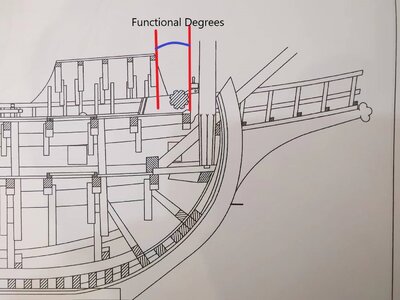
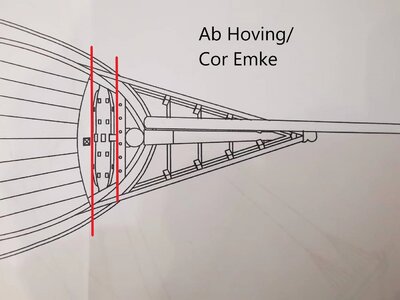
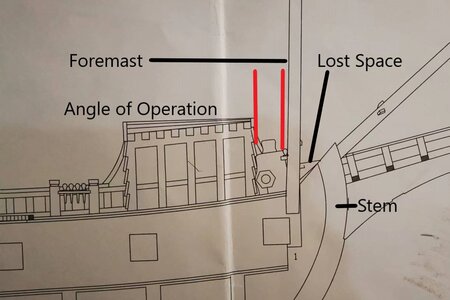
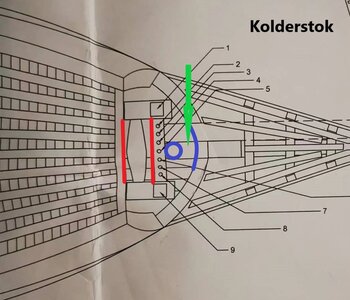
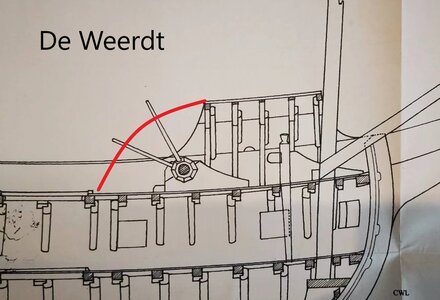

Hi Paul. You have not even worked out your first full month and then you went AWOL on holiday without first clearing it with me! And you expect to be paid???? You should be happy that I have not billed you for office space utilized. I'm part Dutch remember!Great. Now I’ve lost my role as creative director to Richie. That’s what I get for going on holiday and shirking my responsibilities. Good luck in your new position Richie. The pay ain’t great.


Within the given constraints and available information, the current preference for the position of the windlass is a logical one. (By the way, by no means I intended to suggest this location is not feasible or possibly incorrect...) This is also demonstrated by your struggles to get the windlass to work in front of the canopy.Johan I love your response. I was anticipating something like that and I am very happy for the opportunity of thinking aloud again in sharing my thought process. I will attempt to address your cocerns on three fronts: Functionality / The Boats / The Painting
Functionality:
Please take a look at the plans of Ab Hoving and Cor Emke:
View attachment 304088
The red lines are the really important ones (in my opinion) as they indicate the range of operation of the windlass.
View attachment 304087
Ab's plans differ from Kolderstok's in the way that the foremast is right up against the stem. By doing this he gains a little more space than in the Kolderstok configuration. However, how on this orange-round world of ours, would the crew have operated that windlass? What I call the functional degrees of operation is determined here by the roof of the canopy at the front and the height of the belaying pin rack. Even if the ratchet poles could theoretically extend beyond the foremast, their movement would still be severely impeded by the belaying rack mounted directly behind the foremast. Logic tells me this is a kite that is not going to fly.
Now the Kolderstok Plans:
View attachment 304089
Because Hans does not place the foremast right up against the stem, the situation is even worse here, because now there is even less space. Once again the belaying rack and the roof of the front canopy serve as the factors determining the functional operation of the windlass. Not surprisingly, the angle of operation is even smaller than in Ab's layout.
View attachment 304090
The green arrow points to the space that is lost because the foremast does not butt up against the stem.
Now let's look at De Weerdt's configuration:
View attachment 304091
It's a no-brainer. Here the windlass can operate unimpeded and in the way that it was intended. So, purely in terms of functionality, there can be no doubt as to which is the most preferable option.
The Boats:
With De Weerdt's configuration, there is still space for the smaller boat if it is offset slightly to the right or left. Clearly, the bigger boat had to be towed behind the ship - like Ab Hoving said it was.
The Painting:
I am very familiar with Arnold de Lange's work and have featured more of his paintings and drawings in the build log. He may be a contemporary painter, but what he does is exactly the same as Ab Hoving and Gerald de Weerdt, Kolderstok Hans and all of us. We are all "contemporaries" in the context of historical shipbuilding who are interpreting the information that we have. Just like Ab, Gerald and Hans have used De Veer's journal and drawings as resource material and inspiration, Arnold has done the same. He may not be building models, but he is "building" paintings based on De Veer's drawings - that is the only difference.
In summary, there is just no way that I can justify placing that windlass in any other position than where De Weerdt has placed it.

Didn't realize you were getting paid.... at all!Great. Now I’ve lost my role as creative director to Richie. That’s what I get for going on holiday and shirking my responsibilities. Good luck in your new position Richie. The pay ain’t great.
In packets of Nescafé.Didn't realize you were getting paid.... at all!

Johan, please don't let me work undisturbed. I love being disturbed and I love being asked the kind of questions you are asking. This keeps me on my toes and have contributed greatly to me discovering aspects that proved to be crucial to the build. I am glad that you agree my decision is a logical one - at least when they want to certify me, I can call for your support!Within the given constraints and available information, the current preference for the position of the windlass is a logical one. (By the way, by no means I intended to suggest this location is not feasible or possibly incorrect...) This is also demonstrated by your struggles to get the windlass to work in front of the canopy.
Thanks for your extensive reply, again, I hope I'll be able to let you work in peace on this little ship of yours and not to disturb you too much with my questions.


That sounds promising but I will only know the real value when you start putting all this new-found knowledge into practice.Yes, but consider all the added value I bring to my position with my nautical holiday experience.
I’ll be completing my research at the Batavia ship yard on Wednesday. I’ll submit my white paper per our employment contract. Let’s see Richie do better than that.
 Be careful, Richie has access to the Western Australian Museum which houses all the remains of what was found of the original Batavia.
Be careful, Richie has access to the Western Australian Museum which houses all the remains of what was found of the original Batavia.
Exactly Johan!Didn't realize you were getting paid.... at all!
 You would think that some people would do these things for the love of the hobby, but clearly not!
You would think that some people would do these things for the love of the hobby, but clearly not! 
True - but postage on the bottles of Nescafe is just too expensive!In packets of Nescafé.

Better make that booking to visit the museum pronto and lets see what I can do for you Heinrich once the Batavia sees the light of day again.That sounds promising but I will only know the real value when you start putting all this new-found knowledge into practice.Be careful, Richie has access to the Western Australian Museum which houses all the remains of what was found of the original Batavia.




I just love it! Guys among all the work (and frustration sometimes) this kind of banter is what brings a smile to my face every day and makes it all worthwhile. Thank you all for that!Better make that booking to visit the museum pronto and lets see what I can do for you Heinrich once the Batavia sees the light of day again.
Paul may have briefly elevated me to a creative role (first time anyone has called me creative), but sounds like he wants it back badly and pretty sure will even pay Heinrich for the privilege
so no more whinging about poor pay Paul
P.S. Paul if you step down permanently the person filling the position will be handsomely rewarded

Nescafé? Not even real coffee?True - but postage on the bottles of Nescafe is just too expensive!

Always Heinrich, always.at least when they want to certify me, I can call for your support!
